Probably the most misunderstood and problematic of all terrestrial-based disc technology lies at the heart of the German disc programs that started with the birth of the NSDAP (Nazi Party) in 1920- a full thirteen years before Adolf Hitler came to power as the leader of the Third Reich. To fully comprehend the depth of these programs requires the knowledge that above all else the NSDAP was founded from the onset by the occult Thule (1917) and Vril (1919) Gesellschafts (Societies), and other occult groups like the DHvSS (Men of the Black Stone) that stretched back to the turn of the twentieth century with the Old German Order (a.k.a. Order of Teutons). As such, the very first disc project built in Germany..
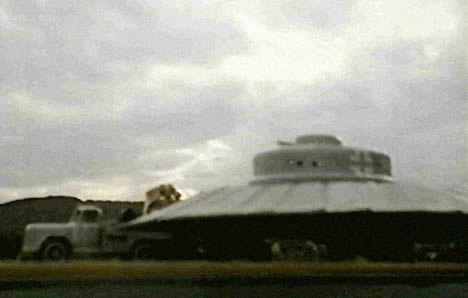
… in 1922 was not even an aircraft but an inter-dimensional flight machine in disc form-the JenseitsFlugMaschine (JFM) built by Thule-Vril using secret business member funding.
When Adolf Hitler (a Thule member along with Goering, Himmler, and various other top Nazi officials) became chancellor of Germany in 1933 the eleven year occult metaphysical science of Thule-Vril became strengthened by official state backing for the continued disc development programs starting with an RFZ (RundFlugZeug), or “Round Aircraft” series of discs that utilized levitators developed by W.O. Schumann of the Technical University of Munich who worked on the mysterious JFM from 1922-24.

1934 saw the first RFZ discs built, RFZ units 1-3. The first RFZ series utilized the Schumann levitators, but often with disastrous results.
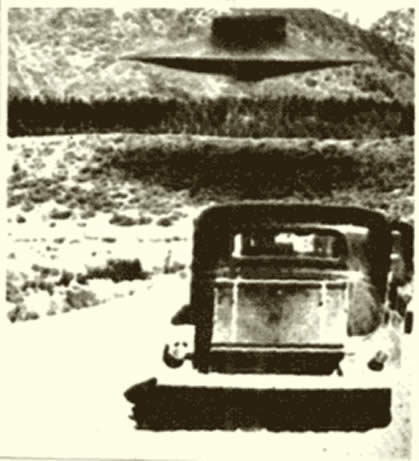
The very first disc, RFZ-1 rose very briefly only to 60 meters before losing control. Pilot Lothar Waiz, testing the machine at Arado-Brandenburg, quickly bailed from the spinning disc whose Ar 196 controls and tail unit failed to function causing the machine to spin out of control and crash into the ground. Not to be discouraged the RFZ-2 was built the same year and achieved a measure of success. This was a small armed disc with two MG that was used in 1940 for recon over the British Isles and in the South Atlantic with a rendezvous with the German raider Atlantis in 1942.
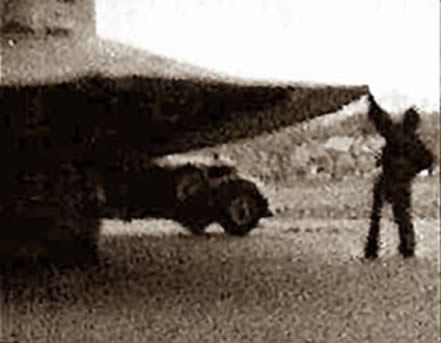
The RFZ 3,4, and 6 were all prototypes that grew larger and more powerful in each subsequent model. They were built from 1934-1940. The RFZ-5 was renamed Haunebu in 1939 with the RFZ-7 becoming the Vril-1 Jager in 1941. These highly advanced disc aircraft were overseen by Himmler’s SS- specifically, the SS Technical Branch Unit E-IV (Entwicklungsstelle 4) which was created to explore various alternative energies. This unit was tasked with developing both the Haunebu and Vril disc designs that utilized the world’s first electro-magnetic-gravitic drive systems: the Vril and Thule Triebwerke.
These drives relied on Hans Coler’s free energy Konverter coupled to a Van De Graaf band generator and Marconi vortex dynamo (a huge spherical tank of mercury) to create powerful rotating electromagnetic fields that affected gravity. Many have often inquired “why” then when war started in 1939 did Germany not use these advanced and unique machines in air combat? The simple truth lies in the fact that these machines, despite their superior overall performance to conventional piston-engined aircraft and early jets, could not be realistically adapted to any useful military role other than the most basic transport and recon work.
The strong electromagnetic engines were difficult to control and required a complex celestial navigation system to fly. While maximum speed and range were incredible for the time, the flight characteristics of the discs could not hope to imitate high-performance fighters like the Me Bf 109 or Fw 190. There was very little room for either offensive or defensive armament in these designs except for a few experimental light MG and MK cannons that proved impractical in flight and a rather large experimental Donar (Thunder) Kraftstrahlkanone (Strong Jet Cannon).
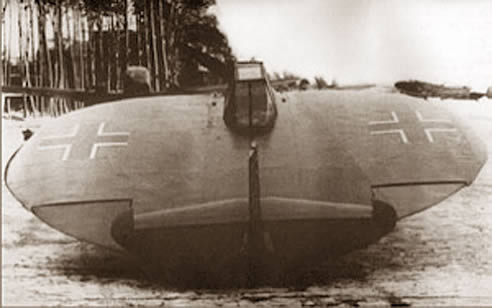
These guns tended to destabilize the discs badly and were eventually removed or replaced with lighter automated guns.
The disc bodies themselves were not capable of carrying any ordnance at all internally or externally (no bombs, rockets, or missiles) and could make only turns of 22.5, 45, and 90 degrees.
Nevertheless, the SS pursued an aggressive policy of theft, forced cooperation, and strong internal development of these types of machines due to the increasing Allied bombing offensive that made conventional aircraft take-offs and landings highly dangerous.
VTOL was seen as the logical solution to this problem. If the SS could develop a production machine that in the future could be armed (with cannon, missiles, or even an electrostatic weapon) then Germany might be able to turn the air war.
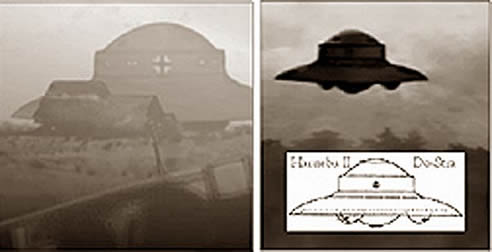
To shorten the time of finding VTOL solutions, the SS robbed both Germany’s patent office and every patent office in occupied Europe.
Those with aeronautical skill enough to contribute to the SS effort were either arrested or coerced into participating in the programs- among them Viktor Schauberger of Austria and Henri Coanda of Rumania. The SS also used its large slave labor force to assist in construction of large underground facilities for these discs and often for production of components to these machines.
Though the SS requested additional slave laborers from Armaments Minister Albert Speer, Speer himself was not told what war projects the laborers would be used for; indeed, Speer was deliberately kept out of the entire SS disc development programs for security reasons and the fact that the SS was a state-within-a-state with its own production facilities, war material, scientists and technicians, slave workforce, and the knowledge of secret Third Reich military bases outside Germany where the discs were both tested and stored.
Among those held, Viktor Schauberger became the leader of most interest due to his highly unconventional use of liquid vortex technology which was perfected while he was in custody at Mauthausen. Originally designed for an odd bio-submarine, the strange Repulsion discoid motors were to be adapted to aircraft.
Heinkel was the first to receive the early results of the discoid motor tests but refused to act on it in the same way the Luftwaffe refused to act on Heinkel’s flight of its first jet aircraft, the He 178, three days before the start of WW2.
A year after the Repulsion Model A motor was being studied one of Heinkel’s own engineers named Rudolf Schriever proposed his own “Flugkreisel” (Flying Gyro) that utilized conventional jet engines instead of the Repulsion discoid motor. His design was taken from him by the SS and handed over to a team of scientists for further study and construction of a large flying prototype, The team consisted of Dr. Richard Miethe, Klaus Habermohl, and Dr.Guiseppe Belluzzo who had come up with his own design for a jet powered round flying bomb- the Turbo Proietti.
Meanwhile, BMW (who was to provide the turbojets for Heinkel’s jets) started work on a design very similar to Schriever’s Flugkreisel but utilizing the company’s own BMW 003 jet engines. These machines, called “Flugelrads” (Winged Wheels) were not true disc aircraft but jet autogyros that used a standard BMW 003 with a Strahlrohr (Jet pipe) deflector to power a multi-blade disc rotor.
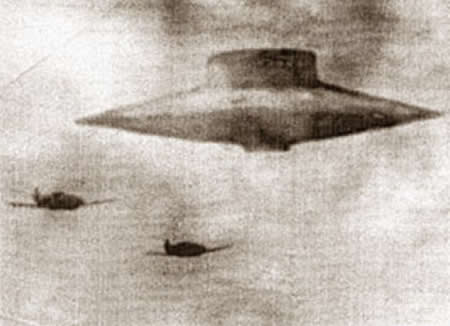
These craft were built on a much smaller scale than Schriever’s Flugkreisel so work proceeded from 1941-45 with construction of prototypes beginning in 1943. Instability, however, was never really solved in the earlier designs. Only one disc, a BMW Flugelrad II V-2 (or V-3) possibly achieved flight in April 1945. Schriever’s own design began to take shape in 1942 and flew in 1943. It flew under jet power provided by three attached special kerosene-burning engines driving the disc rotor as well as two kerosene jets attached to the body for forward thrust and horizontal stability.
Flight characteristics were said to be good but then the SS decided to abruptly drop Schriever’s jet-fan design in favor of Goethe’s version that eliminated the large disc rotor blades driven by jet engines for Schauberger’s liquid vortex engine, but on a larger scale. With Schauberger released back to Austria in 1944 by the SS, the Miethe prototype took to the air the same year over the Baltic. It’s resemblance to the Repulsin Model B was unmistakable except for the addition of a bubble cockpit on top and water drainage (bleed) pipes to the rear of the craft instead of at the bottom. At the same time a private venture with official backing from Air Ministry General Udet was taking shape in Leipzig. Arthur Sack who caught the attention of Udet way back in 1939 with his A.S.1 circular wing flying aero model was given permission and some funding to build a manned large-scale version of his model. Sack took up the challenge and built four more models of increasing size.
When the A.S.5 demonstrated that the basic concept was sound construction began on the manned version in early 1944- the A.S.6. Within a month the strange largely wooden aircraft utilizing salvaged parts from a Me Bf 108 was taxiing and making attempts to fly. But this project was doomed from the start with an underpowered engine and plagued by structural problems which meant that the aircraft could “hop”- but never fly.
Due to round-the-clock bombing the SS was forced to try even more drastic measures, launching unmanned interceptor discs from the Schwarzwald. These discs were known as the “Feuerball” weapon, sometimes erroneously referred to as the mystery V-7 weapon (of which there never was an official designation). The WNF Feuerball relied on a rocket motor for launch, a plume sensor for aerial detection, and an electrostatic field weapon invented at Messerschmitt Oberammergau facility for attack.
Production of these craft was initially performed by WNF under SS direction. Because the discs burned chemicals around its ring to create the electrostatic field necessary to disable Allied bomber engines and radar the object was soon nicknamed the “Foo Fighter” by the Allies who sighted this fiery halo weapon approaching them by day or night. “Foo” was a take on the French word Feu (Fire) and from the Smokey Stover comic of a bumbling fireman that actually started fires!
Naturally, WNF observed the burning effect too and soon nicknamed their weapon the WNF Feuerball (Fireball). The “Feuerballs” plagued the 415th NFS from November 1944 to April 1945. By that time production had been shifted to the Zeppelin Werk that nicknamed their enlarged improved weapon as the “Kugelblitz” (Ball Lightning). The Allies seemed confused by these weapons which ranged in size from small to large and attacked in singles or multiples.
The Germans added to this confusion by introducing two OTHER weapons with the Feuerball/Kugelblitz- the “Seifenblasen” and “Kugelwaffen”. “Seifenblasen” (Soap Bubbles) were large meteorological balloons trailing metal strips that confused Allied radar. Their large round shape and metallic coating reflected in daylight gave them the appearance of a shining globe mistaken for a Feuerball. Along with the Seifenblasen were launched purely spherical aerial probes that were used as psychological weapons. These “Kugelwaffen” (Ball Weapons) played aerial games with the Allied bomber gunners that would have in time distracted them from the real threat of larger approaching Kugelblitz discs.
But by the spring of 1945 the war was lost regardless and most of the remaining programs were halted. Henri Coanda had been arrested in Paris in 1940 and forced to work on a disc under SS supervision. His design for a lenticular disc that benefited from his own “Coanda Effect” was a masterpiece of jet disc design.
But because it required twelve Jumo 004 jets to power the huge machine the project never got past the wind tunnel testing phase. Likewise, Andreas Epps independent Omega Diskus which utilized two Pabst ramjets and eight Argus lift fans was also confined to 1/10th scale model testing. Dr. Alexander Lippisch had also studied disc aerodynes back in 1941 but was too involved in the Me 153 Komet and DM-1 delta glider programs to produce anything more than brief design concepts based on the Gottingen K 1253 circular wing profile. The Horten brother, experts with flying wings, also studied circular wing designs but did not actually work on any in Nazi Germany. They did so for the US Govt. postwar in late 1945-46 producing what is now believed to be the craft that crashed at Roswell in 1947- a spy craft parabolic lifting body carried by a large meteorological balloon.
In the face of imminent defeat BMW destroyed all their Flugelrads and possibly Schriever Flugkreisel which was testing at the same facility. Miette’s disc may have been captured as Miethe went to Canada postwar to work on AVRO’s disc designs. Habermohl was captured by the Russians while Dr. Belluzzo went back to Italy. Schauberger’s Repulsine were captured by the Allies while most of the SS Technical Branch records still intact were captured by the British who postwar attempted to create a working design through AVRO Canada with eventual US assistance.
One very little known Peenemunde disc project under Henrich Fleissner was the last disc to take off from Berlin in late April 1945 on an official mission. But details of the “Dusen Scheibe” (Nozzle Disc) remain clouded in mystery.
Meanwhile, the Feuerball attacks that stopped in April 1945 in Germany resumed in August 1945 in Japan- an obvious technology transfer from Germany to Japan via U-boat. The Japanese, however, lacked all the documentation for this weapon and only launched a few. It is said that the Japanese were frightened by this “demonic thing” and destroyed the remaining Feuerballs by dynamiting them in a pit. Photographic evidence also seems to identify “Kugel Waffen” sent to Japan as several are seen trailing Sally bombers, probably for flight testing.
But the Third Reich story ends as strangely as it had begun. What about the mysterious Thule-Vril discs which were actually built in small numbers? By 1945 there were quite a few Haunebu II and Vril 7 discs flying. Vril had even tested the Vril 8 Odin and possibly even the more streamlined Vril 9 Abjager. These craft were not destroyed but evacuated from March 1945 to an area safe from Allied bombing or capture.
In the year preceding the start of WW2 Germany sent an expedition to Antarctica to scout out a location for a military base there. The Germans found such a location in the former Queen Maud Land which Germany renamed Neu Schwabenland. There, in secret during 1942-43, a base was built in the Muhlig-Hoffman Mountains. Base 211 (or Station 211). The base was supplied with slave laborers shipped by sea and U-boats to construct an elaborate cave complex deep within the mountains- an impregnable fortress. Hot internal springs were found there, iron ore deposits, vegetation, and access was achieved primarily through an underwater trench that ran through the area.
During the war, especially the latter part, German U-boats made frequent trips to the South Atlantic, South America, and Antarctica. Germany also set up floating meteorological buoys in Antarctic waters and weather stations on islands located between Antarctica and the tip of South America. The SS RuSHA (Rasse und SiedlungsHauptAmt- Race and Settlement Bureau) began in 1942 to take women of Aryan decent (Volksdeutsche) from the Ukraine solely for the purpose of transporting them to Base 211.
Ten thousand women between the ages of 17-24, blonde and well proportioned, were recruited for the project along with 2,500 Waffen SS soldiers serving in Russia. The goal of this massive undertaking was to create a colony at Base 211 suitable for the habitation and continued development of the Thule-Vril technology. It is believed that both the Thule and Vril Gesellschafts evacuated that technology to Base 211 at the close of the war under SS General Kammler, who was in charge of Germany’s most secret weapons programs. Two U-boats that surrendered after the war in Argentina are also believed to have carried cargo and high-ranking SS to Base 211. Both boats were empty upon surrender with the crews refusing to disclose their cargos and destinations.
It became apparent in 1946 that 54 U-boats and over 6,000 technicians and scientists were “missing” from Germany- especially from the SS Technical Branch.
There were also 40,000 slave laborers and between 142,000-250,000 German citizens unaccounted for. Despite simply writing these off as probable losses and deaths of the war, Washington suspected that a large number of these missing actually escaped to South America and Base 211 (if such a base existed). The United States then went on the hunt using the “war criminal” propaganda to cover up the search for technology akin to a South American version of “Operation Paperclip”.
The United States was so concerned about the secret base that in 1947 with the first Antarctic summer “Operation Highjump” was launched with a full military task force headed by Admiral Byrd. The task force was to head straight for Neu Schwabenland and recon the area for a base. If one was found 4,700 armed troops would have been sent to capture or destroy it. The task force performed the aerial recon, trailing magnetometers to detect any magnetic anomalies under the ice… but several of Byrd’s planes were lost. The aircraft had run into enemy opposition.
“Operation Highjump” ended in failure as Byrd headed back after several weeks, far short of the eight months that was intended. In his unofficial comments to the South American press Byrd stated that he was attacked by “enemy aircraft that could fly from pole to pole at incredible speed”. Subsequently, the modern UFO phenomenon sprang up in 1947 and concentrated disc development programs were initiated in the 1950s that have continued on to present-day “black project” aircraft operated by the CIA, NSA, and NRO. So the story of the Third Reich disc programs does not end with the collapse of the Third Reich itself.

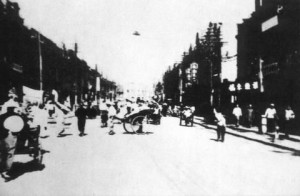
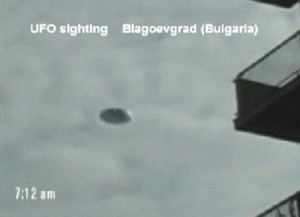
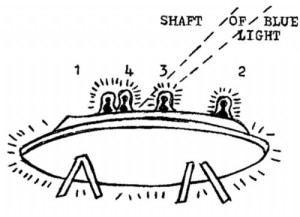
Related Reports
1034: UFO in The Nuremberg Chronicle
1125: Railbach, Freienstein, Germany Burning Man?
1138: Dwarf sighting in Germany